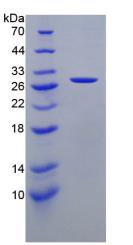Recombinant Cathepsin K (CTSK) 

CTS-K; CTS02; CTSO; CTSO1; CTSO2; PKND; PYCD; Pycnodysostosis; Cathepsin O; Cathepsin X
Overview
Properties
- Product No.RPA267Hu01
- Organism SpeciesHomo sapiens (Human) Same name, Different species.
-
Applications
Positive Control; Immunogen; SDS-PAGE; WB.
If bio-activity of the protein is needed, please check active protein.
Research use only - DownloadInstruction Manual
- CategoryEnzyme & KinaseInfection immunityBone metabolism
- Source Prokaryotic expression, Host E.coli
- Endotoxin Level<1.0EU per 1µg (determined by the LAL method)
- Subcellular LocationLysosome
- Molecular Mass 27.2kDa, Accurate 30kDa(Analysis of differences refer to the manual)
- Residues & TagsAla115~Met329 with N-terminal His Tag
- Buffer Formulation20mM Tris, 150mM NaCl, pH8.0, containing 1mM EDTA, 1mM DTT, 0.01% SKL, 5% Trehalose and Proclin300.
- Traits Freeze-dried powder, Purity > 95%
- Isoelectric Point9.0
Share your citation
Upload your experimental result
Review
Leave a message
Loading...
Sign into your account
Share a new citation as an author
Upload your experimental result
Review
Please attach serial No. on instruction manual


Contact us
Please fill in the blank.
Name*
Organization
Address
E-mail address*
Telephone
Inquiry*
Verification code*

Sequence

Usage
Reconstitute in 20mM Tris, 150mM NaCl (pH8.0) to a concentration of 0.1-1.0 mg/mL. Do not vortex.
Storage
Avoid repeated freeze/thaw cycles. Store at 2-8°C for one month. Aliquot and store at -80°C for 12 months.
Stability
The thermal stability is described by the loss rate. The loss rate was determined by accelerated thermal degradation test, that is, incubate the protein at 37°C for 48h, and no obvious degradation and precipitation were observed. The loss rate is less than 5% within the expiration date under appropriate storage condition.
Increment services
-
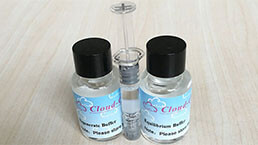 Endotoxin Removal Kit
Endotoxin Removal Kit
-
 BCA Protein Quantification Kit
BCA Protein Quantification Kit
-
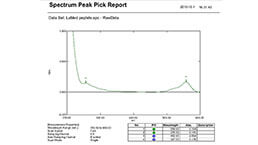 Protein Labeling Customized Service
Protein Labeling Customized Service
-
 Molecular Mass Marker for Protein
Molecular Mass Marker for Protein
-
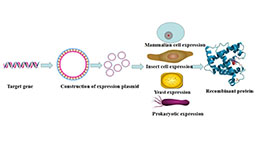 Recombinant Protein Customized Service
Recombinant Protein Customized Service
-
 Monoclonal Antibody Customized Service
Monoclonal Antibody Customized Service
-
 Polyclonal Antibody Customized Service
Polyclonal Antibody Customized Service
-
 Protein Activity Test Experiment Service
Protein Activity Test Experiment Service
-
 Immunoprecipitation (IP) Experiment Service
Immunoprecipitation (IP) Experiment Service
-
 Buffer
Buffer
-
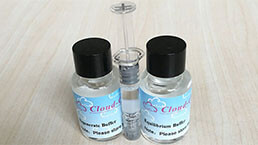 Endotoxin Removal Kit II
Endotoxin Removal Kit II
-
 Real Time PCR Experimental Service
Real Time PCR Experimental Service
-
 Spike RBD Protein (S-RBD)
Spike RBD Protein (S-RBD)
-
 Protein G
Protein G
-
 Protein A
Protein A
Citations
- MRMT-1 rat breast carcinoma cells and models of bone metastases: improvement of an in vitro system to mimic the in vivo condition.PubMed: S0065128112000773
- Biochemical and clinical correlation of intraplaque neovascularization using contrast-enhanced ultrasound of the carotid arteryPubmed:24534452
- Drynaria total flavonoids decrease cathepsin K expression in ovariectomized ratsPubmed:25036175
- In vitro method for the screening and monitoring of estrogen-deficiency osteoporosis by targeting peripheral circulating monocytesPubMed: 26250906
- Cathepsin K Contributes to Cavitation and Collagen Turnover in Pulmonary TuberculosisPubMed: 26416658
- Effect of Vitamin D on Peripheral Blood Mononuclear Cells from Patients with Psoriasis Vulgaris and Psoriatic Arthritispmc:PMC4822855
- TSC1 regulates osteoclast podosome organization and bone resorption through mTORC1 and Rac1/Cdc42Pubmed:29358671
- Comparative evaluation of cathepsin K levels in gingival crevicular fluid among smoking and nonsmoking patients with chronic periodontitisPubmed: 30409937
- A bioactive exopolysaccharide from marine bacteria Alteromonas sp. PRIM-28 and its role in cell proliferation and wound healing in vitroPubmed: 30851325
- Biomarkers of Compromised Implant Fixation
- Compound K induces neurogenesis of neural stem cells in thrombin induced nerve injury through LXRα signaling in micePubmed: 32371156
- Информационный алгоритм неинвазивной оценки остеорезорбтивного побочного действия глюкокортикостероидов у больных язвенным колитом
- Особенности остеоиммунологических аспектов остеорезорбции при периимплантите, хроническом пародонтите и раке альвеолярного отростка и …






